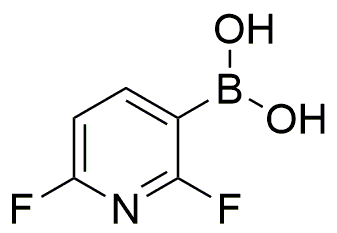2,6-Difluoro-3-pyridineboronic acid is widely utilized in research focused on:
- Pharmaceutical Development: This compound plays a crucial role in the synthesis of various pharmaceuticals, particularly in creating targeted therapies for cancer treatment. Its boronic acid functionality allows for the formation of stable complexes with biomolecules.
- Organic Synthesis: It is used as a building block in organic synthesis, facilitating the formation of carbon-carbon bonds through cross-coupling reactions. This is particularly valuable in the development of complex organic molecules.
- Material Science: The compound is employed in the development of advanced materials, such as sensors and catalysts, due to its unique electronic properties and ability to form stable complexes.
- Agricultural Chemistry: It has applications in the design of agrochemicals, helping to create more effective pesticides and herbicides that target specific pests while minimizing environmental impact.
- Analytical Chemistry: This chemical is used in various analytical techniques, including chromatography and mass spectrometry, to enhance the detection and quantification of specific analytes in complex mixtures.
General Information
Properties
Safety and Regulations
Applications
2,6-Difluoro-3-pyridineboronic acid is widely utilized in research focused on:
- Pharmaceutical Development: This compound plays a crucial role in the synthesis of various pharmaceuticals, particularly in creating targeted therapies for cancer treatment. Its boronic acid functionality allows for the formation of stable complexes with biomolecules.
- Organic Synthesis: It is used as a building block in organic synthesis, facilitating the formation of carbon-carbon bonds through cross-coupling reactions. This is particularly valuable in the development of complex organic molecules.
- Material Science: The compound is employed in the development of advanced materials, such as sensors and catalysts, due to its unique electronic properties and ability to form stable complexes.
- Agricultural Chemistry: It has applications in the design of agrochemicals, helping to create more effective pesticides and herbicides that target specific pests while minimizing environmental impact.
- Analytical Chemistry: This chemical is used in various analytical techniques, including chromatography and mass spectrometry, to enhance the detection and quantification of specific analytes in complex mixtures.
Documents
Safety Data Sheets (SDS)
The SDS provides comprehensive safety information on handling, storage, and disposal of the product.
Product Specification (PS)
The PS provides a comprehensive breakdown of the product’s properties, including chemical composition, physical state, purity, and storage requirements. It also details acceptable quality ranges and the product's intended applications.
Certificates of Analysis (COA)
Search for Certificates of Analysis (COA) by entering the products Lot Number. Lot and Batch Numbers can be found on a product’s label following the words ‘Lot’ or ‘Batch’.
Numéro de catalogue
Numéro de lot/série
Certificates Of Origin (COO)
This COO confirms the country where the product was manufactured, and also details the materials and components used in it and whether it is derived from natural, synthetic, or other specific sources. This certificate may be required for customs, trade, and regulatory compliance.
Numéro de catalogue
Numéro de lot/série
Safety Data Sheets (SDS)
The SDS provides comprehensive safety information on handling, storage, and disposal of the product.
DownloadProduct Specification (PS)
The PS provides a comprehensive breakdown of the product’s properties, including chemical composition, physical state, purity, and storage requirements. It also details acceptable quality ranges and the product's intended applications.
DownloadCertificates of Analysis (COA)
Search for Certificates of Analysis (COA) by entering the products Lot Number. Lot and Batch Numbers can be found on a product’s label following the words ‘Lot’ or ‘Batch’.
Numéro de catalogue
Numéro de lot/série
Certificates Of Origin (COO)
This COO confirms the country where the product was manufactured, and also details the materials and components used in it and whether it is derived from natural, synthetic, or other specific sources. This certificate may be required for customs, trade, and regulatory compliance.


